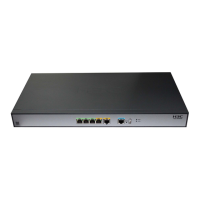300
To address this issue, you can configure this command to exclude the unsupported attributes from
portal protocol packets sent to the portal authentication server.
You can specify multiple excluded attributes.
Table 41 describes all attributes of the portal protocol.
Table 41 Portal attributes
UserName 1 Name of the user to be authenticated.
PassWord 2 User password in plaintext form.
Challenge 3 Random challenge for CHAP authentication.
ChapPassWord 4 CHAP password encrypted by MD5.
TextInfo 5
The device uses this attribute to transparently transport prompt
information of a RADIUS server or packet error information to the portal
authentication server.
The attribute value can be any string excluding the end character '\0'.
This attribute can exist in any packet from the device to the portal
server. A packet can contain multiple TextInfo attributes. As a best
practice, carry only one TextInfo attribute in a packet.
UpLinkFlux 6 Uplink (output) traffic of the user, an 8-byte unsigned integer, in KB.
DownLinkFlux 7 Downlink (input) traffic of the user, an 8-byte unsigned integer, in KB.
Port 8 Port information, a string excluding the end character '\0'.
IP-Config 9
This attribute has different meanings in different types of packets.
• The device uses this attribute in ACK _AUTH (Type=0x04)
packets to notify the portal server that the user requires re-DHCP.
• The device uses this attribute in ACK_LOGOUT (Type=0x06) and
NTF_LOGOUT (Type=0x08) packets to indicate that the current
user IP address must be released. The portal server must notify
the user to release the public IP address through DHCP. The
device will reallocate a private IP address to the user.
BAS-IP 10
IP address of the access device. For re-DHCP portal authentication,
the value of this attribute is the public IP address of the access device.
Session-ID 11
Identification of a portal user. Generally, the value of this attribute is the
MAC address of the portal user.
Delay-Time 12
Delay time for sending a packet. This attributes exists in
NTF_LOGOUT (Type=0x08) packets.
User-List 13 List of IP addresses of an IPv4 portal user.
EAP-Message 14
An EAP attribute that needs to be transported transparently. This
attribute is applicable to EAP TLS authentication. Multiple
EAP-Message attributes can exist in a portal authentication packet.
User-Notify 15
Value of the hw_User_Notify attribute in a RADIUS accounting
response. This attribute needs to be transported transparently.
BAS-IPv6 100 IPv6 address of the access device.
UserIPv6-List 101 List of IPv6 addresses of an IPv6 portal user.
Examples
# Exclude the BAS-IP attribute (number 10) from portal packets sent to MAC binding server 123.
<Sysname> system-view
[Sysname] portal mac-trigger-server 123

